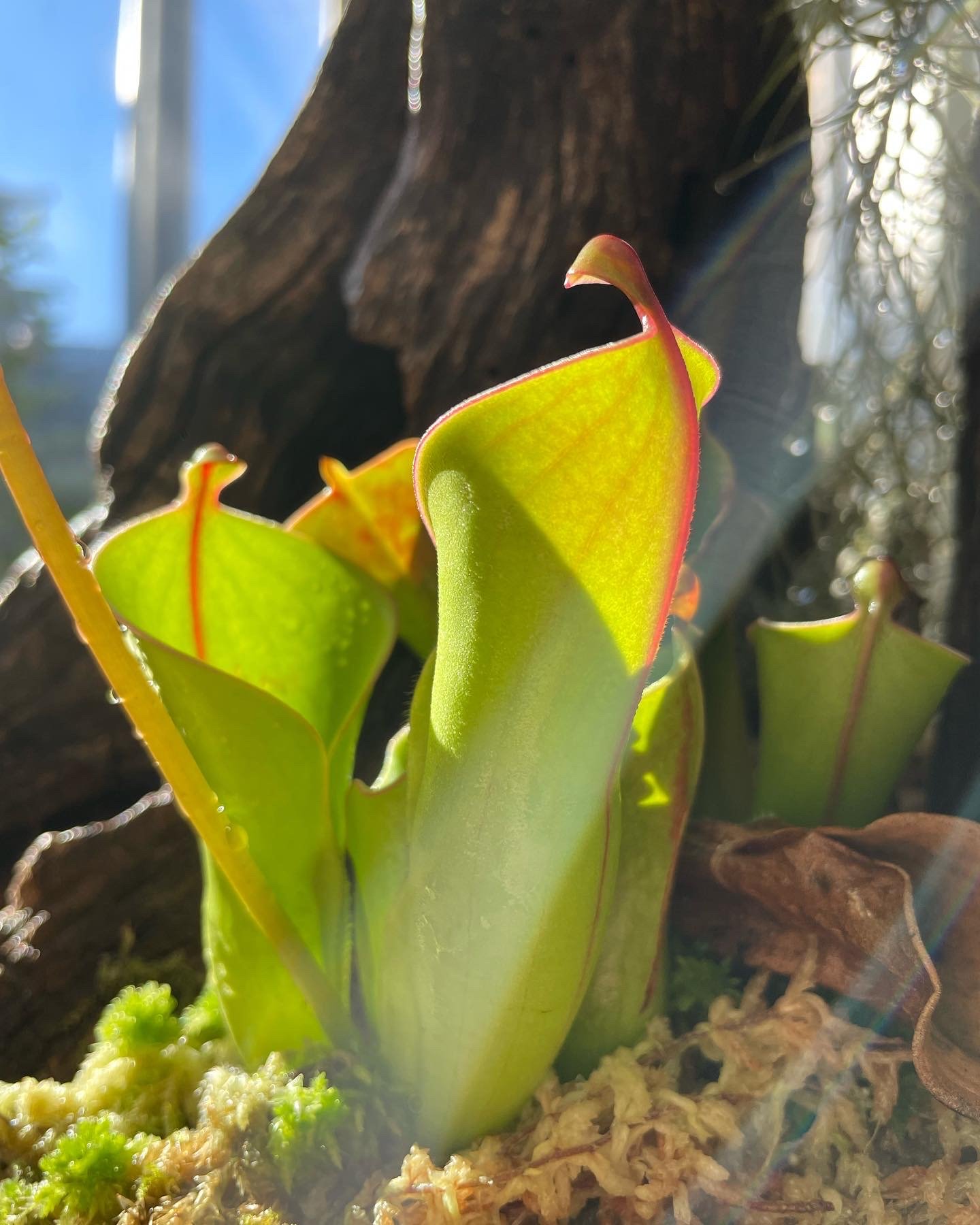PHOTOS
Pictured: USBG Mediterranean Climate House, March 2024
Here, you'll find a collection of images from my career as a professional horticulturist. Enjoy exploring the diverse and intricate world of plants through my work.
Carnivorous Plants
I am captivated by carnivorous plants and I specialize in growing carnivores of all genres. From growing carnivores for UMD plant sales, to installing new carnivorous plant displays at the US Botanic Garden, I have experience in all aspects of these beautiful plants.
Drosera falconeri is a heat loving sundew from Australia. This species gives insight as to how a plant like the Venus flytrap may have evolved. Can you see the resemblance?
One of my favorite ways of sharing the joy of carnivorous plants is through creating mixed container gardens.
Drosophyllum lusitanicum, the dewy pine, is a unique carnivorous plant from Spain and Portugal. Native to a Mediterranean climate zone, this plant not only captures insects with its leaves, but also fog; this helps them to survive long, dry summers.
Utricularia nelumbifolia, a species of bladderwort from Brazil, can grow as an epiphyte in the tanks of bromeliads.
Sarracenia Cherry Cola is a hybrid of S. leucophylla and S. alata.
The tropical carnivorous plant display at the USBG features carnivorous plants from all over the world. I planned and installed this display in October 2022.
This vibrant bog features carnivorous plants native to the Southeastern United States, showcasing Sarracenia's beautiful, bee pollinated flowers.
Sarracenia leucophylla, the white-topped pitcher plant, is native to the southeast United States. It times its largest pitchers with the harvest moon, to attract night-flying insects.
Heliamphora heterodoxa x minor is a hybrid sun pitcher plant that tolerates hot, mid-atlantic summers. This plant is representative of the species native to the Tepuis in South America.
This display showcases various species of pitfall carnivores. Nepenthes x ventrata, a species of pitcher plant from the Philippines, typically grows as a liana—vines that begin in the soil and climb into long, trailing structures. Brocchinia, a carnivorous bromeliad, hails from the table-top mountains (tepuis) of South America.
Venus flytraps (Dionaea muscipula) can be seen planted in mass in the native wetland in USBG's Southern Exposure. This is a new display I installed in 2023, and consists of all US Native carnivorous plants.
This highland form of Nepenthes veitchii grows happily under grow lights in my kitchen.
I created this Mexican Butterwort dish garden in early 2022. It blooms prolifically through spring and summer, and consists primarily of Pinguicula Seductora.
Nepenthes maxima is a striking tropical pitcher plant, named for its size. This tropical liana captures insects using its pitcher shaped foliage.
Mediterranean
Climate House: USBG
While working at the United States Botanic Garden, I completed an overhaul of the Mediterranean Climate display. This display shifted from plants commonly seen in Mediterranean-style gardens to emphasis on native plants of the five Mediterranean climate zones of the world.
Plants were primarily selected based on their nativity: and should have distributions in the five Mediterranean climate zones (South and southwest coastal Australia, coastal Chile, coastal California and southern Oregon, the Mediterranean basin, and the western cape of South Africa).
A special emphasis was placed on plants with the following characteristics: winter-growing trees and shrubs, winter annuals, bulbs, plants with heat/drought-adapted trichomes (silver plants), plants with unique fragrances, and Mediterranean climate zone carnivorous plants.
The Mediterranean Climate House springs to life during winter. With temperatures ranging from 42F to 65F, cool growing plants thrive.
Scilla madeirensis, or Madeiran squill blooms in late winter with beautiful, lavender flowers. Endemic to Madeira, this bulb enjoys the mild temperatures in the Mediterranean display
Echium wildpretii, the tower of jewels, is native to the Island of Tenerife. Growing on rocky volcanic slopes, this plant is a challenge to grow in the Mid-Atlantic. Zack was able to bloom this plant for the first time in USBG history during spring, 2024.
Echium wildpretii, Lampranthus aureus, and Melianthus major make their debut during mid-spring. These bright flowers are complimented by the herbal fragrances of plants of the Maquis and Chaparral.
With a name like Canarina canariensis (Canary Island bellflower), it's easy to guess where this plant is native to. This summer-dormant perennial from the Canary Islands relies on fleshy, tuberous roots to survive the dry Mediterranean climate. It produces edible, yellow fruits in early spring.
Orchids
I have been growing and collecting orchids since early childhood. While at the USBG, I oversaw large proportions of the orchid collection including slipper orchids, high-elevation orchids, and Cymbidium. In addition to caring for orchid collections, I have experience planning and installing large and small-scale orchid displays.
Phragmipedium kovachii is a rare slipper orchid from Peru. This orchid bloomed for the first time, after 17 years in the USBG's collection while under my care.
Taeniophyllum pusillum, an aphyllous orchid from Southeast Asia, produces minuscule yellow and white flowers.
This rotational display of orchids emphasizes American Cattleya breeding.
As part of my responsibilities at USBG, I executed rotational displays of orchids in the Orchid Display House, using the collections under my care.
Slipper orchids in bloom, getting ready to be put on display.
Paphiopedilum Wellesleyanum is a beautiful hybrid of P. concolor and P. godefroyae.
Vanda species appreciate bright light and warm temperatures.
As part of the 2023 orchid show, I installed this bed featuring orchid pollination adaptations.
I enjoy creating thematic pot displays for various occasions. This impromptu Valentine's display featured pink orchids from the USBG collection.
Cypripedium parviflorum was one of the species of US native orchid under my care at the USBG.
Paraphalaenopsis labukensis is a unique orchid native to Borneo.
Stanhopea tigrina is a striking plant, pollinated by euglossine orchid bees.



































